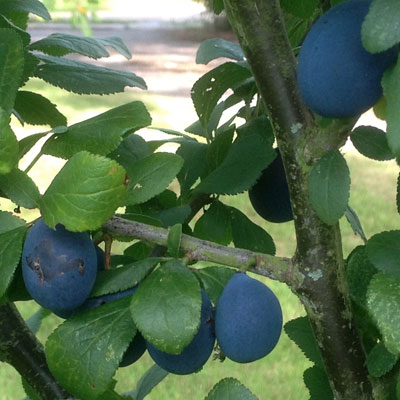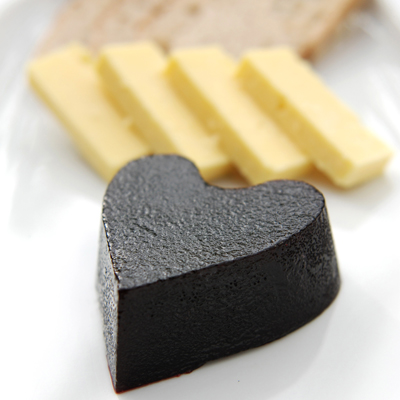I must confess to having a love affair with damsons. With their blue-black skin and astringent/sweet flavour they are a firm favourite. Of all the stone fruits available to the preserver, the damson is the maestro.
Available from September, to early October, they are high in pectin and acid. Damsons are unique as they make almost every type of preserve including jam, jelly, butter, cheese, sauce, syrup, chutney, pickle, vinegar and gin.
As soon as they are just ripe, with some give when pressed gently, they are perfect for jams and jellies. As they ripen further, I use them to make damson cheese, and chutney. When the fruit starts to fall from the trees, it’s time to make damson gin. These three preserves benefit from being left for a few months for their flavours to mature although that can be difficult, if like me you are naturally impatient to taste them.
Originating in Damascus, Syria, the Crusaders brought damsons back to Europe. Originally, they were known as damscene, later shortened to damson.They became abundant in Cumbria, Kent, Shropshire and Worcestershire, where trees were planted to supply dye for the carpet industry in Kidderminster, from the skins of the fruit.
Where to see Damsons
 In Cumbria, in April, a Damson Day, organised by the Westmorland Damson Association is held in the Lyth Valley at a time when the trees are covered in white blossom. They have long lives, up to 50 years and best propagated from small suckers from the roots of established trees. https://www.lythdamsons.org.uk
In Cumbria, in April, a Damson Day, organised by the Westmorland Damson Association is held in the Lyth Valley at a time when the trees are covered in white blossom. They have long lives, up to 50 years and best propagated from small suckers from the roots of established trees. https://www.lythdamsons.org.uk
The National Trust has a damson orchard at Brockhampton, Herefordshire. When the fruit is ripe, the orchard is open to the public for picking in return for a donation. https://www.nationaltrust.org.uk/visit/worcestershire-herefordshire/brockhampton/reimagining-lost-orchards-project-at-brockhampton
The National Damson and Bullace Collection is held at the Ironbridge Gorge Museum Trust in the arboretum behind the Darby Houses. https://www.ironbridge.org.uk/visit/darby-houses/
Varieties
My favourite variety of Damson is the Shropshire Prune. Apart from its distinctive sweet- tart flavour, peculiar only to Damsons, they are larger than the varieties that I have at home, less stones to count in and out when making jam.
In Somerset I have frequently been surprised to see under-ripe damsons for sale in
markets, during August and early September. An under-ripe damson is very sour and the skin firm to the touch. Plums with clingstones, when the flesh sticks strongly to the pit are frequently mistaken for damsons. Whilst the exterior colour of some varieties of plum might be similar to damsons, the flavour of a plum is nothing like a damson. To showcase their flavour in preserves, I like to use my pressure cooker to make jelly and cheese, as it also saves time and energy.
Damson Jelly. Pressure Cooker Method 
Makes around 1.1kg
1.4kg damsons
500ml water
675g granulated cane sugar
1.Start the jelly the evening before adding the sugar to the juice. Wash the fruit and put it into a pressure cooker with the water.
2. Bring the pressure cooker to high pressure and cook for 5 minutes. When safe to open the pressure cooker, mash the cooked mixture then transfer it to a scalded jelly bag suspended over a large bowl. Leave the bag to drip overnight. Do not squeeze the bag as that will make the jelly cloudy.
3. The next day, measure the juice in the bowl, there should be at least 900ml. Transfer 900ml of juice to a large preserving pan. Put the sugar in an ovenproof bowl in a low oven 140C/275F/Gas1. for 30minutes.
4. Dissolve the sugar in the juice. Bring to a rolling boil. Test for a set after 5 minutes using the flake, or thermometer test. When setting point is reached, remove the pan from the heat. Remove any scum with a metal spoon. Gently stir the jelly, pour it into clean jars and seal with new twist top lids. Leave the jars upright and undisturbed until cold.
Damson Cheese Pressure Cooker Method
Often served with a cheese course, this unusual preserve makes an attractive gift, and keeps its flavour for years. It’s eaten also with bread or with cold meats. My favourite way is to serve it as a petit four cut into small shapes, and dipped in melted chocolate. Fruit cheeses are traditionally potted in small, straight sided containers. When turned out, their colour is bright, deep, even and rich.They should cut cleanly and not be soft or sticky.
Makes around 1.5kg
1.4kg damsons
150ml water
Granulated sugar
1. Wash the damsons and put them into a pressure cooker. Add the water
2. Bring the pressure cooker to high pressure and cook for 5 minutes. When safe to open the pressure cooker, transfer the cooked mixture to a sieve and with a spoon, vigorously sieve out a purée into a bowl.
3. Measure the purée, there should be around 1.12kg. Pour the pulp into a preserving pan and cook it gently to drive off any excess water.
4. Weigh out 450g sugar for each 450g of measured purée. Dissolve the sugar into the purée and continue to cook, for about 35-40 minutes, stirring regularly until a clean line can be drawn with a spoon through the base of the pan
5..Pour the fruit cheese into clean, hot ramekins or small moulds lightly greased with glycerine. Seal with waxed discs and cellophane covers.


